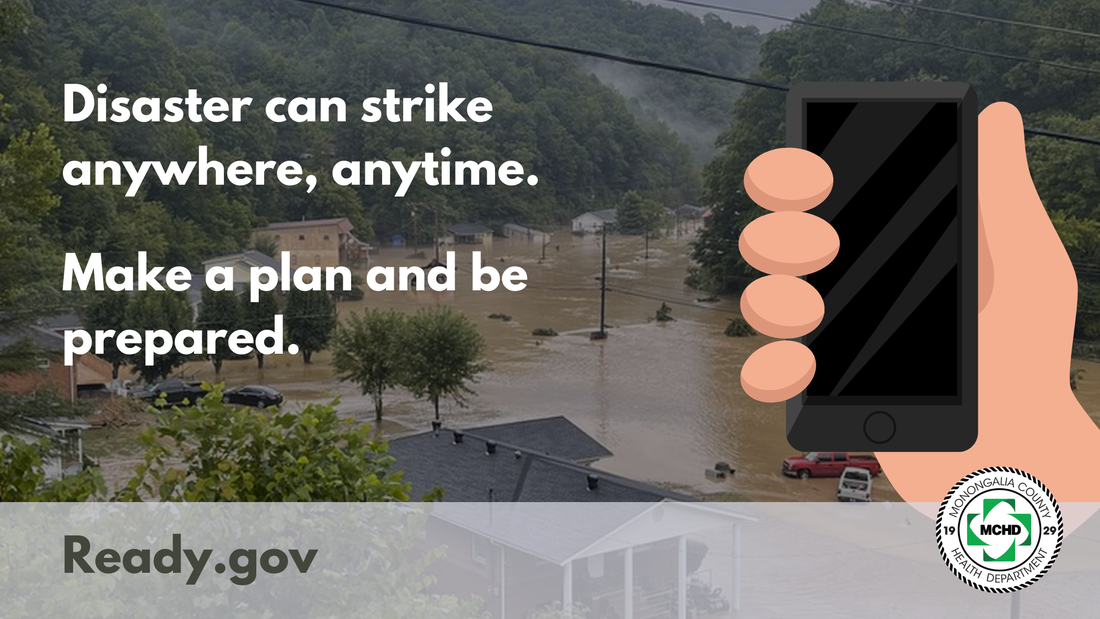When disaster strikes Appalachia, preparedness can save lives

Sep. 21, 2022
By Katie Minor
Just last month, our neighbors in Kentucky suffered devastating losses due to flooding.
At least 37 people have died and whole communities have been swept away. As fellow Appalachians, this tragedy hits very close to home.
As Kentuckians work to rebuild their communities, we’re reminded of why being prepared for such an emergency is so important. September is National Preparedness Month, promoted by the national Ready Campaign.
Flooding is perhaps the most likely natural threat we face in Appalachia. We’ve even seen small flash floods in Monongalia County over the past few years, reminding residents that it is never safe to try to walk or drive through flood water. Remember: turn around, don’t drown!
The Ready Campaign breaks down preparedness into four steps. The first one is to make a plan for yourself, your family and your friends.
First up is figuring out how you will know an emergency is on the way. In this day and age of cell phones and a 24-hour news cycle, this can be easier than ever. Also in play is IPAWS, or the Integrated Public Alert and Warning System that was developed in the aftermath of Hurricane Katrina. IPAWS can deliver a Wireless Emergency Alert (WEA) via a 90-character text to mobile devices in case of emergency. The WEA will tell you the type of alert and what you should do in response.
Texting also might be the best way to contact a loved one in an emergency, as it is not unprecedented for cell phone service to be interrupted or spotty during chaotic circumstances. Plus, it’s good to have a back-up plan for your family to have a rendezvous location in case you can’t contact each other when a situation arises. Create a paper copy of contact information for everyone in the family, along with information for doctors or other medical facilities, schools and service providers. Make sure everyone keeps a copy in a purse, backpack or wallet. If you do this online at ready.gov/make-a-plan, you can print out a wallet-sized card.
Next up is figuring out where to take shelter. If you can shelter at home, the location inside your house can vary depending on the type of emergency. For instance, in the case of a tornado, you would want to stay in a basement or an interior room that doesn’t have outside walls or windows.
Other places to shelter also might include your place of employment, with friends or family outside the hazard area or in a mass care facility operated by a disaster relief group. The type of shelter you seek can depend on your circumstances as well as the type of emergency.
In case you do need to shelter inside your home, you should stock up on supplies to have on hand. Ready.gov provides a list of some essential supplies for your emergency kit, including
• Water (one gallon per person per day for several days, for drinking and sanitation)
• Food (at least a three-day supply of non-perishable food)
• Battery-powered or hand crank radio and a NOAA Weather Radio with tone alert
• Flashlight
• First aid kit
• Extra batteries
• Whistle (to signal for help)
• Dust mask (to help filter contaminated air)
• Plastic sheeting and duct tape to shelter in place
• Moist towelettes, garbage bags and plastic ties, for personal sanitation
• Wrench or pliers to turn off utilities
• Manual can opener (for food)
• Local maps
• Cell phone with chargers and a backup battery
And don’t forget your pets. The Ready Campaign has created a plan just for pets. Disaster relief workers have realized first-hand that the effort to save pets has motivated people to stay at home rather than seek a safe shelter or otherwise put them in additional danger. So more and more, pets are included in the planning process for when the unexpected happens. It was heartwarming to see people with their pooches in Houston shelters. And it’s also a good idea to create a separate emergency kit for Fido and Fluffy that includes food and water. Also have photos handy in case you get separated, and make a list of emergency shelters that accept pets.
The next step is to figure out evacuation routes, alternate routes and potential destinations if you do need to leave your home. If you anticipate a potential emergency, make sure to keep your gas tank full. You also need to have a plan to maintain contact with your family as well as to reunite in case you become separated from each other or are not together at the outset of a disaster.
And finally, take the time to go over these steps with your family. Hold regular household meetings to make sure everyone understands the plans that have been created. Ready.gov provides a plan form that can be emailed to each member of your family. If you aren’t together when disaster strikes, you’ll still know what to do.
These are the basic tips to be ready for the unexpected. For more information on how you can be prepared, check out the Ready Campaign’s website.
If you are looking for a way to help Kentucky rebuild, consider donating to flood relief funds such as Team Eastern Kentucky Flood Relief Fund.
Katie Minor is the public information office assistant at Monongalia County Health Department.